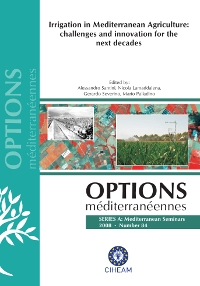| Article précédent | p. 169-176 | Article suivant |
Water management of olive trees (Olea europaea L.) in a hilly environment of Central-South Italy
Olive tree is one of the most tolerant species to water stress. The experiment was carried out in Italy on five olive cultivars: Ascolana tenera, Nocellara del Belice, Itrana Maiatica e Kalamata. Four irrigation treatments were compared: a not irrigated control, a treatment fully irrigated during all season and two deficit irrigation levels that received an amount of water of 33 and 66 percent of ETc from pit hardening stage to fruit veraison. Results showed that a complete replacement of ETc would result in an averaged yield increase of 20 percent in comparison with 66 percent, though applying up to two times the seasonal water amount. So starting irrigation at the pit hardening stage supplying the crop with an amount of water of 66 percent of ETc is feasible for a water saving strategy in this experimental environment. The yield increase was primarily due to the higher fruit weight according to the enhancement in irrigation volume. Yield of the two years was off for all cultivars probably for the high density of plantation that caused difficulties in air circulation. Plantation density was planned under the hypothesis to cut one plant after another within the row after 15-18 years to obtain a final density of 277 plant ha-1.
L'olivier est l'une des espèces qui supportent le mieux le stress hydrique. Cette expérimentation a été menée en Italie sur cinq cultivars: Ascolana tenera, Nocellara del Belice, Itrana Maiatica et Kalamata. On a comparé quatre régimes d'irrigation: une parcelle témoin non irriguée, une parcelle totalement irriguée pendant toute la saison, deux parcelles recevant respectivement un apport d'eau égal à 33 et 66 pour cent de l'ETc à partir du stade de durcissement du noyau jusqu'à la véraison. Si l'on compare la production obtenue et l'eau reçue par la parcelle totalement irriguée et celle recevant 66 pour cent de l'ETc, on constate qu'en dépit d'un apport en eau jusqu'à deux fois supérieur à l'apport saisonnier, la production des plantes totalement irriguées n'augmente que de 20 pour cent. En conclusion, pour notre expérimentation, un régime d'irrigation apportant 66 pour cent de l'ETc pendant la phase de durcissement du noyau est réalisable et permet une économie d'eau. L'augmentation de la production a été principalement causée par l'accroissement du poids des drupes correspondant à l'augmentation du volume d'irrigation. Les rendements n'étaient pas significatifs pour aucun des cultivars au cours de ces deux ans en raison probablement de la haute densité de la plantation qui a empêché une bonne circulation de l'air. Cette densité était basée sur l'hypothèse d'une coupe alterne dans chaque rangée d'arbres, après 15 à 18 ans. On aboutirait ainsi à une densité finale de 277 plantes par ha-1.
- [ Afficher ]
- [ Télécharger ]
- [ Exporter la citation ]
Vous pouvez télécharger la citation au format :
- [ Imprimer ]
-
Mots-clés
DEVELOPPEMENT BIOLOGIQUE, DOSE D'IRRIGATION, ITALIE, OLEA EUROPAEA, RELATION PLANTE EAU, RENDEMENT DES CULTURESCiter cet article
Lavini A., D'Andria R., Patumi M., Morelli G., Tognetti R., Sebastiani L. Water management of olive trees (Olea europaea L.) in a hilly environment of Central-South Italy. In : Santini A. (ed.), Lamaddalena N. (ed.), Severino G. (ed.), Palladino M. (ed.). Irrigation in Mediterranean agriculture: challenges and innovation for the next decades. Bari : CIHEAM, 2008. p. 169-176. (Options Méditerranéennes : Série A. Séminaires Méditerranéens; n. 84). International Conference on Irrigation in Mediterranean Agriculture: Challenges and Innovation for the Next Decades, 2008/06/17-18, Naples (Italy). http://om.ciheam.org/om/pdf/a84/00800963.pdf



